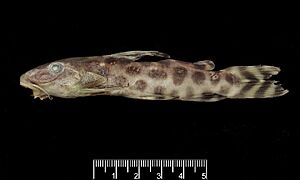Synodontis katangae facts for kids
Quick facts for kids Synodontis katangae |
|
|---|---|
 |
|
| Conservation status | |
| Scientific classification | |
| Genus: |
Synodontis
|
| Species: |
katangae
|
Synodontis katangae is a special kind of upside-down catfish. It lives in the Democratic Republic of the Congo and Zambia. You can find it in the Congo Basin river system.
A scientist named Max Poll first described this fish in 1971. The first fish he studied came from Lukonzolwa, near Lake Mweru. This area is in the Democratic Republic of the Congo. The fish's name, katangae, comes from the Katanga province. This is where the fish was first discovered.
Contents
What Does Synodontis katangae Look Like?
Like other Synodontis fish, S. katangae has a strong, bony head. This head covering goes all the way back to its first dorsal fin spine. It also has a unique bony bump on its head called a humeral process.
This fish has three pairs of whiskers, called barbels. One pair is on its upper jaw. The other two pairs are on its lower jaw. It has a large, soft fin on its back called an adipose fin. Its tail, or caudal fin, is shaped like a fork.
Spines for Protection
The front edges of its dorsal and pectoral fins have stiff, sharp spines. These spines can stand straight out from its body. They can also lock into place. This helps the fish protect itself from danger. Once locked, the spines are very hard to push down.
Unique Teeth
The fish has a special pad of teeth on its upper jaw. These teeth are short and shaped like chisels. On its lower jaw, the teeth are different. They are attached to flexible stalks and look like an "s" shape or a hook.
Size of the Fish
Synodontis katangae can grow up to 24 centimeters (about 9.4 inches) long. Generally, female Synodontis fish are a bit bigger than males of the same age.
Where It Lives and What It Does
In the wild, Synodontis katangae lives in the Luapula-Mweru river system. It is also found in the Luashi River and the Lubumbashi area. People sometimes catch these fish to eat.
Threats to the Fish
This fish faces some dangers. Mining activities can harm its environment. Also, too many fish are sometimes caught. These things can threaten its survival.
What Synodontis Fish Eat
Most Synodontis species are omnivores. This means they eat both plants and animals. They munch on insect larvae, algae, and small water creatures. They also eat the eggs of other fish.
How They Reproduce
Scientists don't know much about how most Synodontis fish reproduce. We know that females can carry many eggs. They likely lay their eggs during the rainy season. This is usually between July and October. During spawning, pairs of fish swim together. Young fish grow very quickly in their first year. Then, their growth slows down as they get older.


